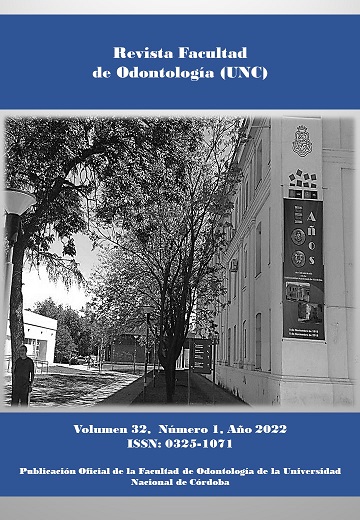Antimicrobial capacity of propolis in pulp therapy
Keywords:
Pulp therapy, propolis, pediatric dentistryAbstract
Introduction: Pulpotomy therapy is a treatment commonly carried out in pediatric patients to counteract the infection present, frequently chemical agents are used as antimicrobials being somewhat contradictory in terms of their effects. Objective: To evaluate the antimicrobial action of 10% ethanolic extract of propolis in pulp therapy of primary dental organs. Materials and Methods: In this study, 10% ethanolic extracto of propolis (EEP) of natural origin was used for the treatment of pulpotomies. Its antimicrobial action was evaluated by collecting microbiological simples before the placement of EEP sample (S1) and after its placement sample (S2). The degree of microbial development was evaluated in McFarland Units and by CFU count at two initial times and 24 hrs. Results: Propolis showed antimicrobial capacity since the results show an average decrease in bacterial growth amog the 20 samples, being from 8.30 to 8.10 in S1 and S2 as well as from 9,18 to 8.96 in S1a ande S2a. The results show an antimicrobial effect, obtaining differences between S1 and S2, results that favor the antimicrobial capacity of propolis. Conclusions: The use of plant extracts or natural derivatives such as propolis for the treatment of pulp therapy such as propolis for the treatment of pulp therapy such as pulpotomies in primary teeth is promising as an alternative to formocresol
References
1. Roby MHH, Sarhan MA, Selim KA-H, Khalel KI. Evaluation of antioxidant activity, total phenols and phenolic compounds in thyme (Thymus vulgaris L.), sage (Salvia officinalis L.), and marjoram (Origanum majorana L.) extracts. Ind Crops Prod 2013; 43: 827–831.
2. Ashish Handa NH, Mahendra S, Mahesh CM, Ramesh Kumar PC, Soumya KM. ‘Propolis’ and its potential in dentistry: a review. Int J Health Sci Res 2012; 1: 143–147.
3. Wieckiewicz W, Miernik M, Wieckiewicz M, Morawiec T. Does propolis help to maintain oral health? Evid Based Complement Alternat Med 2013; 2013:8
4. Kayaoglu G, Omurlu H, Akca G, Gürel M, Gençay Ö, Sorkun K et al. Antibacterial activity of Propolis versus conventional endodontic disinfectants against Enter- ococcus faecalis in infected dentinal tubules. J Endod 2011; 37: 376–381.
5. Parolia A, Kundabala M, Rao NN, Acharya SR, Agarwal p, Mohan M, Thomas M. A comparative histological analysis of human pulp following direct pulp capping with Propolis, mineral trioxide aggregate and Dycal. Aust Dent J 2010; 55(1): 59-64.
6. Ledezma Rasillo, G., Flores Reyes, H., González Amaro, A. M., Garrocho Rangel, A., Ruiz Rodríguez, M. S., Pozos Guillen, A. J. Identification of cultivable microorganisms from primary teeth with necrotic pulps. J Clin Pedriatr Dent 2010; 34(4): 329-334.
7. Sanchez Romero MI, Garcia-Lechuz Moya JM, Gonzalez Lopez JJ, Orta Mira N. Recogida, transporte y procesamiento general de las muestras en el laboratorio de Microbiologia. Enferm Infecc Microbiol Clin 2019; 37(2): 127-134.
8. Howley B, Seale NS, McWhorter AG, Kerins C, Boozer KB, Lindsey D. Pulpotomy versus pulpectomy for carious vital primary incisors: Randomized controlled trial. Pediatr Dent 2012; 34: 112-119.
9. Bulman Z, Le P, Hudson AO, Savka MA. A novel property of propolis (bee glue): anti-pathogenic activity by inhibition of N-acyl-homoserine lactone mediated signaling in bacteria. J Ethnopharmacol 2011; 138:788–797.
10. Lawande S.A, Therapeutic applications of turmeric (Curcuma longa) in dentistry: a promising future. J Pharm Biomed Sci 2013 27(27):586-591.
11. Ozório JE, Carvalho LF, de Oliveira DA, de Sousa-Neto MD, Perez DE. Standardized propolis extract and calcium hydroxide as pulpotomy agents in primary pig teeth. J Dent Child (Chic) 2012; 79: 53-58.
12. Kuropatnicki AK, Szliska E, Krol W. Historical aspects of propolis research in modern times. Evid-Based Complement Alternat Med. 2013; 2013:964149.
13. Ashish Handa NH, Mahendra S, Mahesh CM, Ramesh Kumar PC, Soumya KM. ‘Propolis’ and its potential in dentistry: a review. Int J Health Sci Res 2012; 1: 143–147
14. Alves Esmeraldo MR, Freire de Carvalho MG, Andrade de Carvalho R, Freitas Lima R, Melo de Brito Costa R. Inflammatory effect of green propolis on dental Pulp in rats. Braz Oral Res. (Sao Paulo) 2013; 27(5): 417-422.
15. Hugar SM, Kukreja P, Hugar SS, Gokhale N, Assudani H. Comparative evaluation of clinical and radiographic success of formocresol, propolis, turmeric gel and calcium hydroxide on pulpotomized primary molars: A preliminary study. Int J Clin Pediatr Dent 2017; 10(1): 18-23.
16. Alolofi H, El-Sayed M, Taha S. Clinical and radiographical evaluation of propolis and thymus vulgaris extracts compared with formocresol pulpotomy in human primary molars. BDJ OPEN 2016; 2: 16005. Doi: https://doi.org/10.1038/bdjopen.2016.5
Kusum B, Rakesh K, Richa K. Clinical and radiographical evaluation of mineral trioxide aggregate, biodentine and propolis as pulpotomy medicaments in primary teeth. Restor Dent Endod. 2015;40(4): 276-85. Doi: 10.5395/rde.2015.40.4.276
Published
Issue
Section
License

This work is licensed under a Creative Commons Attribution-NonCommercial-ShareAlike 4.0 International License.
Aquellos autores/as que tengan publicaciones con esta revista, aceptan los términos siguientes:
- Los autores/as conservarán sus derechos de autor y garantizarán a la revista el derecho de primera publicación de su obra, el cuál estará simultáneamente sujeto a la Licencia de reconocimiento de Creative Commons que permite a terceros:
- Compartir — copiar y redistribuir el material en cualquier medio o formato
- La licenciante no puede revocar estas libertades en tanto usted siga los términos de la licencia
- Los autores/as podrán adoptar otros acuerdos de licencia no exclusiva de distribución de la versión de la obra publicada (p. ej.: depositarla en un archivo telemático institucional o publicarla en un volumen monográfico) siempre que se indique la publicación inicial en esta revista.
- Se permite y recomienda a los autores/as difundir su obra a través de Internet (p. ej.: en archivos telemáticos institucionales o en su página web) después del su publicación en la revista, lo cual puede producir intercambios interesantes y aumentar las citas de la obra publicada. (Véase El efecto del acceso abierto).

